Hereford
Hereford United came into existence when two local clubs, RAOC and St Martins FC merged in June 1924. The new club was admitted to the Birmingham Combination League and played its first competitive match two months later. After four seasons, United joined the Birmingham League and gradually became established as one of the leading sides. Because of the association with pedigree Herefordshire beef cattle, the club became known as “The Bulls.” Initially the team played in all-white, a scheme that has reappeared in the 1960s and in 2004.
In 1939, United became a limited company and joined the Southern League only for their new career to be cut short after four matches due to the outbreak of war. When leaguecompetition resumed in 1945, Hereford, now playing in white shirts and black shorts, finished as runners-up to Chelmsford City in rather controversial circumstances. Chelmsford had been awarded a number of points in lieu of matches that had not been played - Hereford's objections were overruled.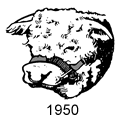
In 1950-51, The Bulls claimed the first of many Football League scalps in the FA Cup, beating Scunthorpe United 1-0. The famous Hereford Bull appeared on the team's shirts during this season, possibly for the first time.
In 1953, United beat Exeter City and in 1956, Aldershot were added to the list. Their giant-killing reputation was firmly established the following season when they hammered Queens Park Rangers (then in the third Division) 6-1 to set up a home tie with Sheffield Wednesday in the Third Round. Although they lost 0-3, the record attendance of 18,114 brought a welcome financial boost. In 1965-66 Third Division Millwall became the Bulls latest victims.
In 1966 the legendary “Gentle Giant,” John Charles signed for the club at the age of 35. Charles scored 115 goals in 202 games and took over as player manager in 1967. Under Charles’ inspirational leadership, Hereford became one of the strongest non-League sides in the country. In October 1971, Charles quit to concentrate on running his sport shop. His successor, Colin Addison would lead the club to its finest achievements.
After holding Newcastle to a 2-2 draw in the FA Cup Third Round, Hereford sensationally won the replay at Edgar Street 2-1 in extra time. It was the first time a First Division side had been knocked out by a non-league team since 1949. In the fourth round, Hereford took West Ham United to a replay before going down 1-3. Their reputation was now made and when the Football league met on June 2nd 1972, The Bulls were elected to the Football League at the expense of Barrow.
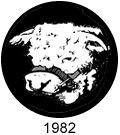 Promoted at the first attempt, United spent three seasons in Division Three before they won the championship and were promoted to the Second Division in 1976. This proved too much of a stretch and the club plunged back down to the Fourth Division in successive seasons. Worse was to come as they had to apply for re-election three times between 1980 and 1983. During these bleak times the players turned out in navy rather than black shorts. It may be that when the Admiral sportswear company went into
Promoted at the first attempt, United spent three seasons in Division Three before they won the championship and were promoted to the Second Division in 1976. This proved too much of a stretch and the club plunged back down to the Fourth Division in successive seasons. Worse was to come as they had to apply for re-election three times between 1980 and 1983. During these bleak times the players turned out in navy rather than black shorts. It may be that when the Admiral sportswear company went into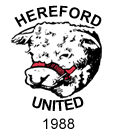 liquidation the Hereford bought up several sets of Tottenham kits in the bankruptcy sale. The club continued to struggle in the lower reaches of the Fourth Division (which became the Third Division when the Football League was re-organised in 1992).
liquidation the Hereford bought up several sets of Tottenham kits in the bankruptcy sale. The club continued to struggle in the lower reaches of the Fourth Division (which became the Third Division when the Football League was re-organised in 1992).
From 1988 the traditional crest was enhanced with the addition of the club's name. This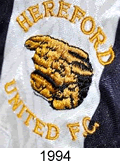 was slightly modified in 1992.
was slightly modified in 1992.
In 1996 United reached the play-offs but the following season, they finished bottom and were relegated to the Conference after a dramatic final day show down with Brighton, who would have gone down had United won the game. Despite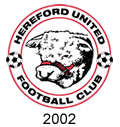 uncertainty over the future of their Edgar Street ground, The Bulls have consistently challenged for promotion back to The League.
uncertainty over the future of their Edgar Street ground, The Bulls have consistently challenged for promotion back to The League.
In 2002 the bull's head crest received a face lift with a design suitable for digital reproduction.
After nine years as a non-league club, Hereford returned to the top level in 2006 after a dramatic 3-2 victory over Halifax Town in the Conference play-off final. In their second season back in the League, Hereford won promotion to League One.
